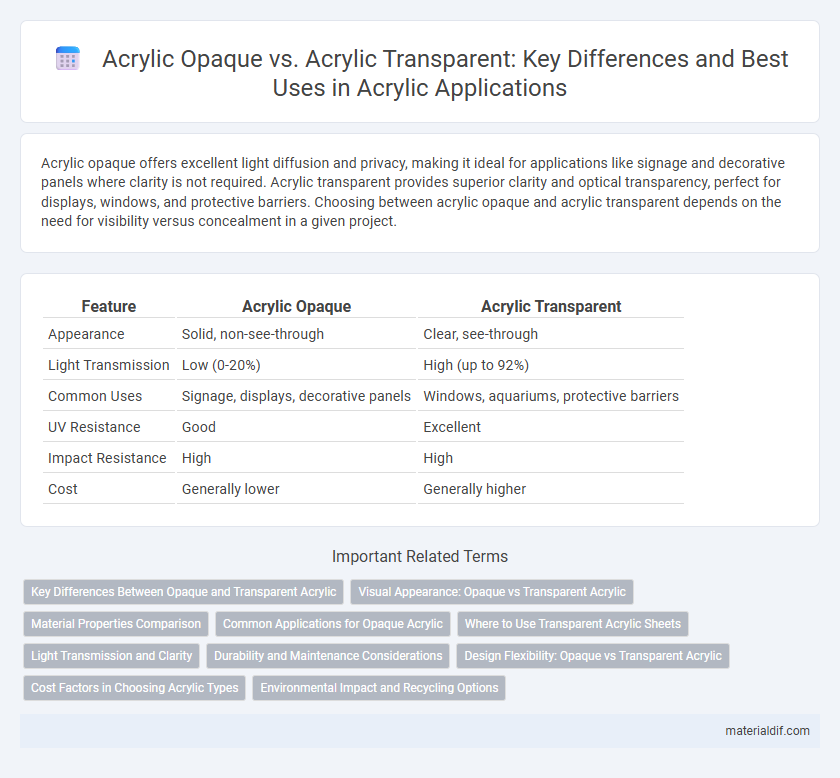Acrylic opaque offers excellent light diffusion and privacy, making it ideal for applications like signage and decorative panels where clarity is not required. Acrylic transparent provides superior clarity and optical transparency, perfect for displays, windows, and protective barriers. Choosing between acrylic opaque and acrylic transparent depends on the need for visibility versus concealment in a given project.
Table of Comparison
| Feature | Acrylic Opaque | Acrylic Transparent |
|---|---|---|
| Appearance | Solid, non-see-through | Clear, see-through |
| Light Transmission | Low (0-20%) | High (up to 92%) |
| Common Uses | Signage, displays, decorative panels | Windows, aquariums, protective barriers |
| UV Resistance | Good | Excellent |
| Impact Resistance | High | High |
| Cost | Generally lower | Generally higher |
Key Differences Between Opaque and Transparent Acrylic
Opaque acrylic displays a solid, non-light-transmitting surface ideal for privacy and bold color applications, while transparent acrylic offers clear visibility and light passage, suitable for displays and glazing. The difference in light transmission affects usage; opaque acrylic provides UV resistance and a matte or glossy finish without transparency, whereas transparent acrylic ensures clarity with excellent optical properties. Both materials offer durability and impact resistance but vary significantly in aesthetic appeal and functional application based on their opacity.
Visual Appearance: Opaque vs Transparent Acrylic
Opaque acrylic offers a solid, non-see-through surface ideal for vibrant color displays and privacy applications, while transparent acrylic provides crystal-clear clarity, enhancing light transmission and visibility. The visual appearance of opaque acrylic is matte or glossy with a consistent color block, whereas transparent acrylic showcases a glass-like finish allowing full translucency. Choosing between these types depends on whether the application prioritizes color intensity and coverage or optical clarity and light diffusion.
Material Properties Comparison
Acrylic opaque offers excellent light diffusion and vibrant color options, making it ideal for signage and decorative applications where light transmission is not required. In contrast, acrylic transparent provides superior clarity and UV resistance, ensuring durability and optimal visibility for windows, displays, and protective barriers. Both materials share high impact resistance and weatherability, but their differing translucency shapes their suitability for distinct functional and aesthetic uses.
Common Applications for Opaque Acrylic
Opaque acrylic is widely used in applications requiring high durability and vibrant color retention, such as signage, displays, and architectural panels. Its non-transparent nature makes it ideal for creating privacy partitions, decorative wall cladding, and promotional materials that demand solid color backgrounds. Compared to transparent acrylic, opaque variants are preferred in manufacturing environments where light diffusion and opacity are crucial for functionality and aesthetics.
Where to Use Transparent Acrylic Sheets
Transparent acrylic sheets are ideal for applications requiring high clarity and light transmission, such as display cases, windows, and protective barriers. Their superior optical properties and weather resistance make them suitable for outdoor signage and aquariums. Transparent acrylic also excels in artistic projects and furniture where visual appeal and durability are essential.
Light Transmission and Clarity
Acrylic transparent offers high light transmission rates up to 92%, providing exceptional clarity and minimal color distortion, making it ideal for applications requiring clear visibility. In contrast, acrylic opaque blocks almost all light, ensuring zero light transmission while delivering solid, vibrant color saturation for privacy or decorative uses. Choosing between opaque and transparent acrylic depends on whether maximum clarity or complete light blockage is the primary requirement for the project.
Durability and Maintenance Considerations
Acrylic opaque panels offer superior scratch resistance and UV stability, making them highly durable for outdoor applications with minimal maintenance. In contrast, acrylic transparent sheets require careful cleaning using non-abrasive materials to prevent surface damage and maintain clarity. Both types resist impact better than glass, but opaque acrylic demands less frequent upkeep due to its ability to conceal scratches and dirt.
Design Flexibility: Opaque vs Transparent Acrylic
Opaque acrylic offers superior design flexibility by providing vibrant solid colors that enhance visual impact and privacy, making it ideal for signage, displays, and furniture with a bold aesthetic. Transparent acrylic allows for clear visibility and light transmission, enabling creative layering, backlighting, and incorporation of graphic elements without obscuring underlying materials. Both types enable precise cutting, shaping, and finishing, but the choice depends on whether light diffusion or concealment is the primary design requirement.
Cost Factors in Choosing Acrylic Types
Acrylic opaque sheets generally cost less than acrylic transparent ones due to differences in raw material processing and pigmentation. Transparent acrylic requires higher purity and clarity standards, increasing production expenses and final price. Budget considerations often guide choices, with opaque acrylic preferred for cost-sensitive applications where visibility through the material is not essential.
Environmental Impact and Recycling Options
Acrylic opaque and acrylic transparent differ significantly in their environmental impact and recycling options due to their distinct chemical compositions and additives. Opaque acrylic often contains pigments and fillers that complicate recycling processes, resulting in lower recyclability and increased environmental burden compared to transparent acrylic, which generally offers better purity and easier reprocessing. Transparent acrylic waste can be more efficiently recycled into new sheets or compounds, reducing landfill volume and conserving resources, whereas opaque acrylic frequently requires energy-intensive methods or is downcycled into less valuable products.
Acrylic Opaque vs Acrylic Transparent Infographic

 materialdif.com
materialdif.com